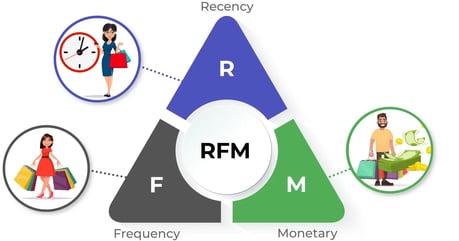Customer-Centric E-Commerce: Benefits and Top 10 Tactics To Implement
As an eCommerce business, it is good to focus on the products you sell or the services you provide; however, it’s not enough anymore. To survive the fierce competition that we see in the eCommerce sector today, you need to place all your focus on the individuals who buy these products or use these services, also known as YOUR CUSTOMERS.
The idea of businesses placing their customers at the heart of everything isn’t new. However, we can say that eCommerce businesses are realizing its significance more and more every day. This concept is referred to as “Customer-Centric eCommerce”.
In this article, we will discuss the meaning of customer-centric eCommerce, its benefits, and the best tactics to use while implementing this approach. Keep reading to know more.
Table of content:
- What Is Customer-Centric E-Commerce?
- What Are The Benefits Of a Customer-Centric Approach For E-Commerce?
- Best 10 Tactics To Use For Customer-Centric E-Commerce:
- Focus on RFM Customer Segmentation.
- Invest In Research And Customer Data.
- Create Customer Personas.
- Regularly Follow Customers’ Journeys.
- Make Personalization A Habit.
- Offer Good Customer Support.
- Create An Omnichannel Experience.
- Do Not Forget Loyalty Programs!
- Work On Optimizing User Experience (UX).
- Measure, Monitor, And Use Metrics.
What Is Customer-Centric E-Commerce?
 Source: sloanreview
Source: sloanreview
Customer-centric eCommerce, or a customer-centric approach to eCommerce, is defined as a business strategy that focuses mainly on customers and puts them at the center of everything related to the business, whether business activities, decisions, plans, or anything else.
E-Commerce businesses that adopt the customer-centric approach prioritize the customers and their well-being at all costs. They prioritize customers’ needs, wants, preferences, and experiences. In other words, customer-centric eCommerce involves prioritizing the personalization of customers’ experiences and the optimization of the customer journey.
Additionally, customer-centric eCommerce is based on the belief that customers are the most important thing in the business and that providing excellent customer experience leads to the achievement of customer loyalty, which in turn results in more sales and profits.
What Are The Benefits Of a Customer-Centric Approach For E-Commerce?
 Image source: walkerinfo.com
Image source: walkerinfo.com
After understanding what a customer-centric approach is, it is time you become aware of its benefits and advantages so that you can better understand why you should start adopting it for your eCommerce store.
- Enhances Customer Satisfaction: It all starts with customer satisfaction. If you are successful at making your customers feel satisfied, then consider yourself successful at everything else. Adopting a customer-centric approach shows your online store’s customers that you care about them and put them first. To better illustrate, customer-centric eCommerce requires you to focus on your customers, appreciate them, value them, and do your best to meet their expectations. All this automatically enhances your customers’ satisfaction.
- Improves Customer Loyalty and Retention: When your customers are satisfied and feel that you value them more than money and profits, it increases their trust in your eCommerce brand. Increased trust leads to an increased repeat purchase rate and retention rate. It also results in long-term relationships.
- Reduces Customer Acquisition Costs: When you work on fostering long-term relationships with your current customers, it saves you from repeatedly having to acquire new ones, which results in a reduced customer acquisition cost.
- Optimizes Conversion Rates: Conversion rate optimization is already something that all eCommerce businesses try to achieve, and it is guaranteed with a customer-centric approach. This is because a customer-centric approach involves creating a seamless frictionless experience for your customers, which facilitates the conversion process for them.
- Increases Competitiveness: When you increase the satisfaction of your customers, improve customer loyalty and retention, reduce customer acquisition costs, and optimize conversion rate, it’s only a matter of time before your competitiveness hits the sky. Customer-centricity will differentiate your eCommerce store from competitors and gives it a strong competitive edge.
Best Tactics To Use For Customer-Centric E-Commerce
You got excited, didn’t you?
Don’t worry! We won’t leave you without telling you everything you need to know to start pursuing customer-centric eCommerce. In the following points, we will walk you through some of the best tactics you can use to apply the customer-centric approach to your eCommerce business.
1- Focus on RFM Customer Segmentation
 Image source: rfmcube.com
Image source: rfmcube.com
In the eCommerce world, every good strategy starts with solid customer segmentation. However, at this point, we are not going to tell you about the significance of segmentation because it’s old news. We are to discuss with you a type of segmentation that many people are not very familiar with, which is RFM Segmentation.
RFM stands for three words: Recency, Frequency, and Monetary.
Are you still feeling confused? Let us explain a bit more about what we’re talking about here.
RFM is a type of analysis that can be used in customer segmentation. It allows you to segment your customers based on three criteria:
- Recency: When was the last time the customer made a purchase?
- Frequency: How often does the customer buy a product or use a service within a given period of time?
- Monetary Value: How much money does the customer spend within a given period of time?
Using RFM segmentation will allow you to have a 360-degree view of your customers and keep an eye on your customer lifetime value. It will also help you better understand your customers, get closer to them, and retain them. All this is the essence of a customer-centric approach.
Speaking of segmentation and 360-customer view, Converted.in offers you an automation tool that can conduct customer segmentation for you in addition to gathering all your customer data in one place like a hub.
2- Invest In Research And Customer Data
As we said before, customer-centric eCommerce requires you to know a lot of things about your customers, and to do that; you have to conduct research regularly and gather as much data about your customers as possible.
There are many places from which you can gather customer data, such as website analytics, surveys, questionnaires, browsing and buying history, social media…etc. The important thing is to make sure that the data you are gathering is accurate and relevant.
Also, work on analyzing the data you gather because there is no point in accumulating data over data if you’re not gonna analyze them to get useful insights about your customers, such as their wants, needs, preferences, behaviors, and others.
3- Create Customer Personas
A customer persona, also known as a buyer persona, is simply a fictional character that you create and that resembles your ideal customer or a certain segment of your target audience. In other words, a buyer persona is like a detailed profile about your target customer or target segment. Creating customer personas is the most convenient step after conducting research and gathering customer data.
You should know that customer personas are essential when following a customer-centric approach because they help you imagine your target customers more clearly and understand them on a deeper level. Imagine these customer personas as if they are the references you go back to whenever you want to make any business-related decision.
4- Regularly Follow Customers’ Journeys
The customer’s journey is another crucial aspect when it comes to customer-centric eCommerce. You cannot prioritize your customers if you are not following each customer’s journey and carefully mapping it.
As you know, your products or services should be providing solutions to problems that your customers are having. To do that, you have to always be aware of these problems and keep up with their dynamic nature. The customer’s journey highlights these problems and takes them to the surface so that you can see them. Hence, mapping your customers’ journeys is your way to address your customers’ problems.
5- Make Personalization A Habit
Customers now are always expecting personalization. As an eCommerce business that’s trying to follow a customer-centric approach, you should do your best to meet this expectation and deliver perfectly personalized customer experiences.
Implement personalization everywhere possible, such as in product recommendations, email marketing campaigns, content marketing…etc. Leverage every possible opportunity to make each one of your customers feel that they are special and that you are tailoring your efforts and strategies for them.
6- Offer Good Customer Support

You didn’t think that we’ll skip talking about customer support, did you?
No one can forget about customer support when talking about customer-centric eCommerce or even eCommerce in general.
Luckily for you, today, technologies and AI-powered tools have made it so easy for eCommerce businesses to provide great customer support. For instance, AI-powered chatbots can now respond immediately and effectively to different types of customers’ inquiries.
Effective customer support gives you the chance to enhance your eCommerce brand’s reputation and strengthen your relationship with your customers through two things:
- Resolving Problems: Through customer support, you can offer help to customers who are facing problems with your products, services, or website or customers who have different types of complaints. By doing this, you are showing your customers that you are completely dedicated to making them feel satisfied.
- Gathering Feedback: Customer support is a great channel to gather customer feedback, which is another thing that you take care of when following a customer-centric approach. Customer feedback is the key to improving and enhancing your brand and what it offers.
7- Create An Omnichannel Experience
An omnichannel experience is when you offer your products or services to customers across all channels, platforms, and devices available. This is done with the aim of engaging users; and, hopefully, keeping them loyal to the brand.
Omnichannel experiences refer to giving your customers the room to move between different channels, platforms, and devices, which increases convenience and provides them with a cohesive and seamless shopping experience. It also shows customers that your brand will always follow them wherever they are.
8- Do Not Forget Loyalty Programs!
Loyalty programs are a great strategy to increase customer retention; therefore, they work hand in hand with a customer-centric approach.
Loyalty programs represent a strategy made especially for the customers, which means that it places them right in the center of it. By offering rewards, incentives, and personalized experiences, loyalty programs show a dedication to understanding and engaging with individual customers.
9- Work On Optimizing User Experience (UX)
If you are not familiar with the term “User Experience”, we are here to tell you what it means.
User Experience, also referred to as UX, is defined as the overall experience a user has when he or she is interacting and navigating through your eCommerce website or other digital platforms, such as mobile applications.
Your job is to optimize the user experience as much as you can. For example, you can do this by:
- Facilitating the navigation process through your website and mobile app.
- Providing customers with relevant content.
- Offering customers easy access to desired products or services.
- Facilitating the checkout process.
- Reducing frictions.
10- Measure, Monitor, And Use Metrics
The final tactic you’ll need when implementing a customer-centric approach is measuring and monitoring. You should always measure your results and monitor your customers using effective metrics, such as:
- Net Promotor Score (NPS): This is a metric that helps you measure customer loyalty by identifying what is the possibility of your customers recommending your products or services to others.
- Customer Lifetime Value (CLV): This is a metric that helps you determine the total net profit your eCommerce store can expect to generate from one customer over the entire duration of their relationship.
To sum up, after discussing the concept of customer-centric eCommerce in detail, it is obvious now that eCommerce businesses need to take advantage of this powerful approach that places customers at the heart of all strategies. In other words, we believe it’s time to take your eyes away from product-centricity and start shifting your attention a bit more to customer-centricity.
 By
By
